
1introjunos
.pdf
Not
Introduction to JUNOS Software
User InterfaceReproductionOptions
The slide lists the topics we cover in this chapter. We discuss the highlighted topic
first. for
User Interface Options • Chapter 3–3
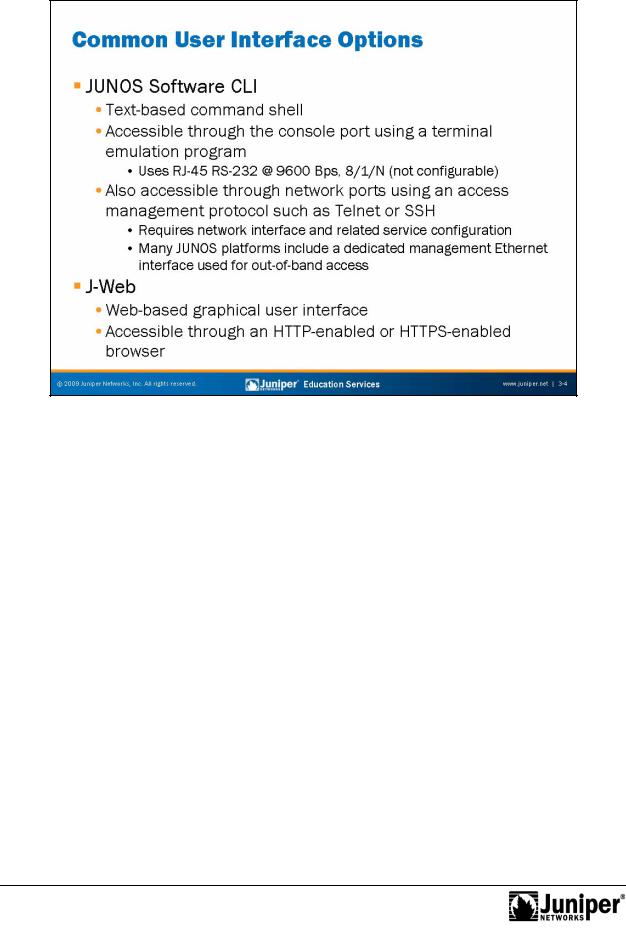
Introduction to JUNOS Software
JUNOS Software CLI
The JUNOS Software CLI is a text-based command shell. One option for accessing the |
||||
CLI is through the out-of-band (OoB) serial console connection. The console port |
||||
settings, shown on the slide, are predefined and are not user configurable. |
||||
A second pti |
|
Reproduction |
||
n f accessing the CLI is over the network (in band) using access |
||||
protocols such as Telnet or SSH. Unlike the console connection, these access options |
||||
require con iguration for a network port and the access protocol. |
||||
Many pla |
|
running JUNOS Software also offer a dedicated management Ethernet |
||
|
|
forms |
|
|
p |
rt. This management port provides OoB access; therefore, the software cannot |
|||
f |
rward transit traffic through this management port. The actual name of the |
|||
dedicated management Ethernet port varies between platforms. For details on your |
||||
specific platform, refer to http://www.juniper.net/techpubs/ for the technical |
||||
Notpublications. |
|
|
||
J-Web Interface
The J-Web is a Web-based graphical user interface (GUI) that you access by using either Hypertext Transfer Protocol (HTTP) or HTTP over Secure Sockets Layer (HTTPS). It provides quick configuration wizards to simplify the most common configuration tasks. For more complicated configurations, the J-Web GUI allows you to directly edit the system’s text configuration file. The J-Web GUI is installed and enabled by default on most platforms running JUNOS Software.
Chapter 3–4 • User Interface Options
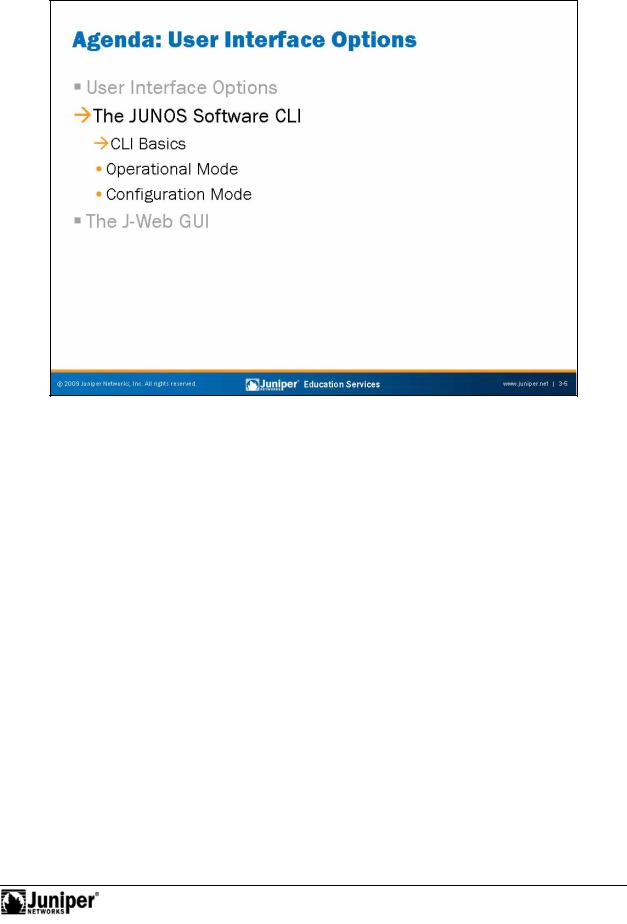
Introduction to JUNOS Software
|
|
Reproduction |
|
The JUNOS Software CLI: CLI Basics |
|
|
The slide highlights the topic we discuss next. |
|
Not |
for |
|
|
|
|
User Interface Options • Chapter 3–5
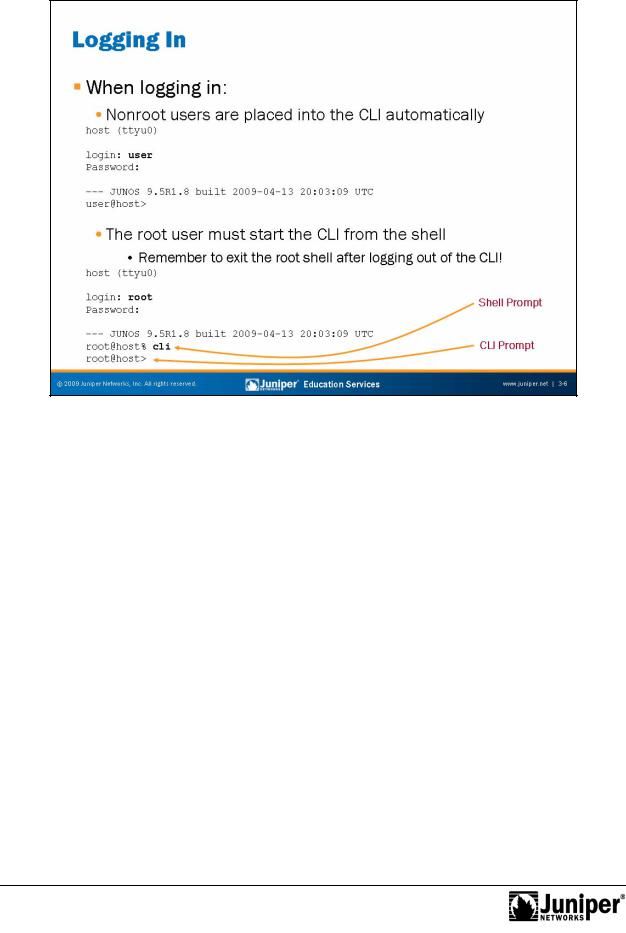
Introduction to JUNOS Software
Logging In
When con igu ed, the console login displays the hostname of the device. When you have not c n igured a hostname, as is the case with a factory-default configuration,
Notthe sof ware displays Amnesiac in place of the hostname:
Amnesiac (ttyu0)
JUNOS Software requires a username and a password for access. The administrator |
|
creates user accounts and assigns permissions. All platforms running JUNOS |
|
Software have only the oot user configured by default, without any password. |
|
for |
Reproduction |
|
|
--- JUNOS 9.5R1.8 built 2009-04-13 20:03:09 UTC root@%
The root user has complete access and control of the device. When you log in as the root user, the software places you at the UNIX shell. You must start the CLI by typing the cli command. When you exit the CLI, you return to the UNIX shell. For security reasons, ensure that you also log out of the shell by using the exit command.
Chapter 3–6 • User Interface Options
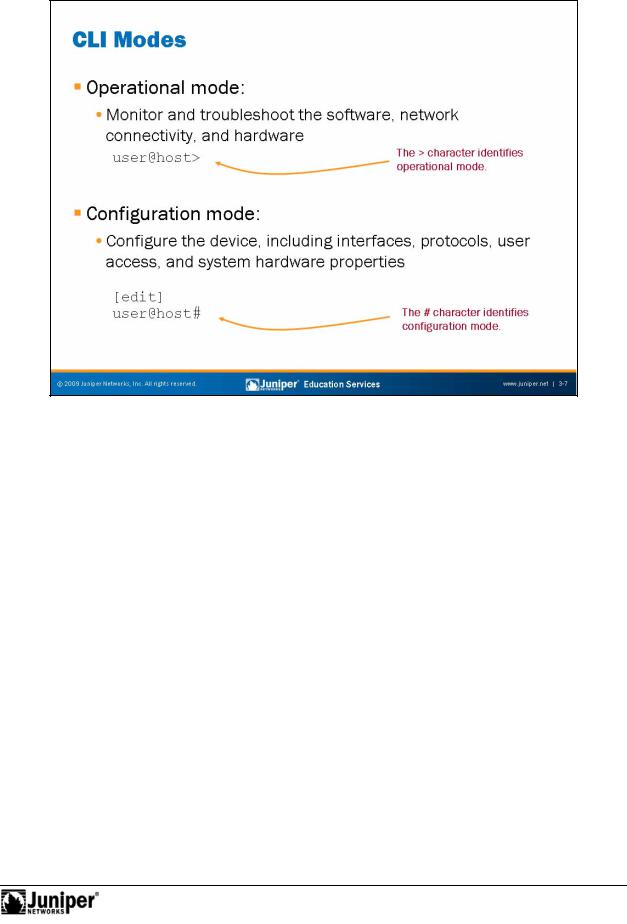
Introduction to JUNOS Software
OperationalReproductionMode
In operational mode, you use the CLI to monitor and troubleshoot the device. The informationmonitor, ping, show, test, and traceroute commands let you display
and test network connectivity for the device.
C iguration Mode
NotIn configuration mode, you can configure all properties of JUNOS Software, including in erfaces, protocols, and user access, as well as several system hardware properties.
User Interface Options • Chapter 3–7
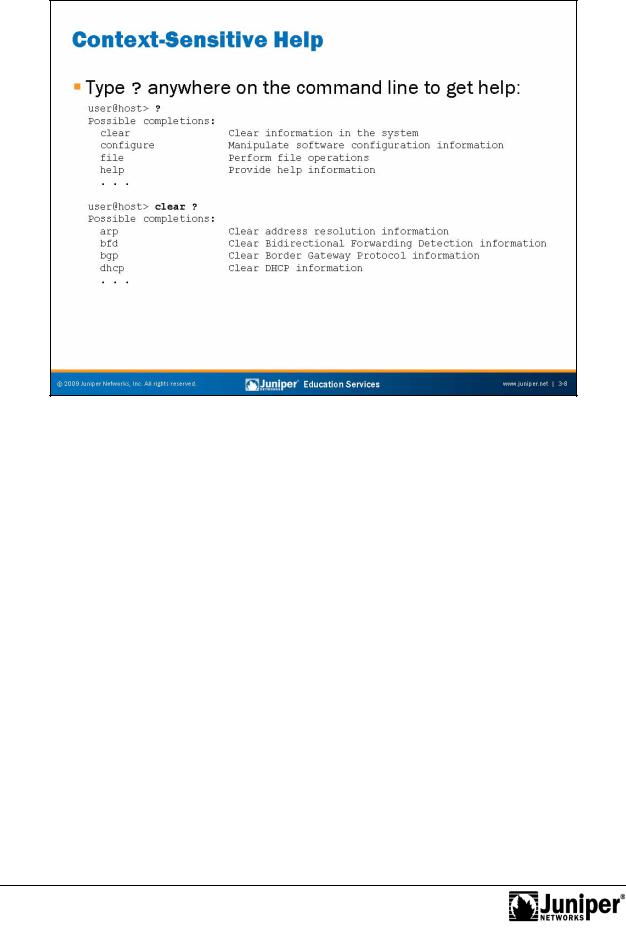
Introduction to JUNOS Software
The CLI provides contextReproduction-sensitive help at any point in a command line. Help tells you which optionsfora e acceptable at the current point in the command and provides a
brief description of each command or command option.
To receive help at any time while in the JUNOS CLI, type a question mark (?). You do not need to press Enter. If you type the question mark at the command-line prompt, Notthe CLI lis s the available commands and options including user-defined variables at
the appr priate context. If you type the question mark after entering the complete name f a command or an option, the CLI lists the available commands and options and then redisplays the command name and options that you typed. If you type the question mark in the middle of a command name, the CLI lists possible command completions that match the letters you have entered so far and then redisplays the letters that you typed.
Chapter 3–8 • User Interface Options
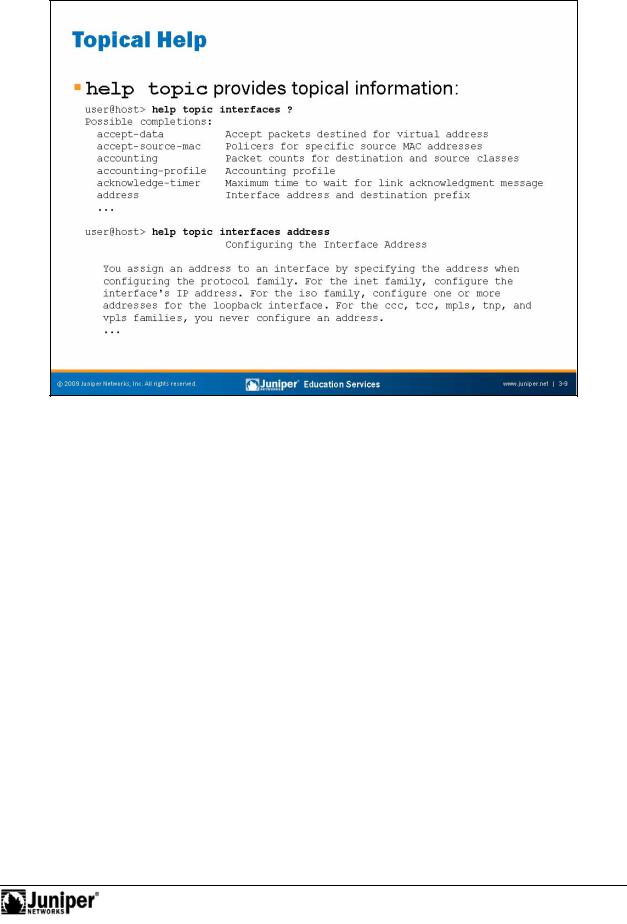
Not
Introduction to JUNOS Software
Help on GeneralReproductionConc pts
You can use the help command in various ways. The help topic command
displays usage guidelines for the statement. In the example on the slide, we receive information on configuring an interface address.
User Interface Options • Chapter 3–9
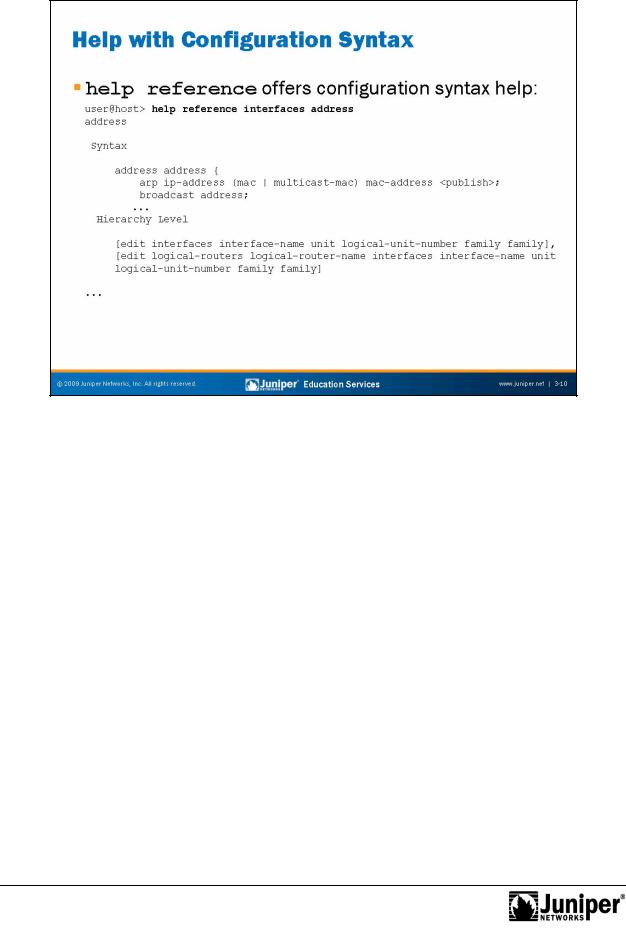
Introduction to JUNOS Software
Help with JUNOS SoftwareReproductionConfiguration
The help reference command displays summary information for the referenced configuration statement. In the example the slide, once again, we are seeking help with interface add essing. Although not shown on the slide, the help reference
command displays a complete list of related configuration options along with several
other details specific to the referenced command statement. |
|
In addi ion the help topic and help reference commands, JUNOS Software |
|
also |
ffersforhe help apropos command. The help apropos command displays |
the c |
ntexts (typically set commands) that reference a specified variable. The |
Notf ll wing is an example of the help apropos command:
[edit system archival configuration] user@host# help apropos archive
set archive-sites
List of archive destinations
set archive-sites <url> password <password> Password for login into the archive site
The help apropos command only displays contexts that are relevant to the configuration hierarchy level at which you are currently positioned. In other words, if you entered the sample command shown, at the [edit] hierarchy level you would see all possible references rather than just those that are applicable to the [edit system archival configuration] hierarchy level.
Chapter 3–10 • User Interface Options
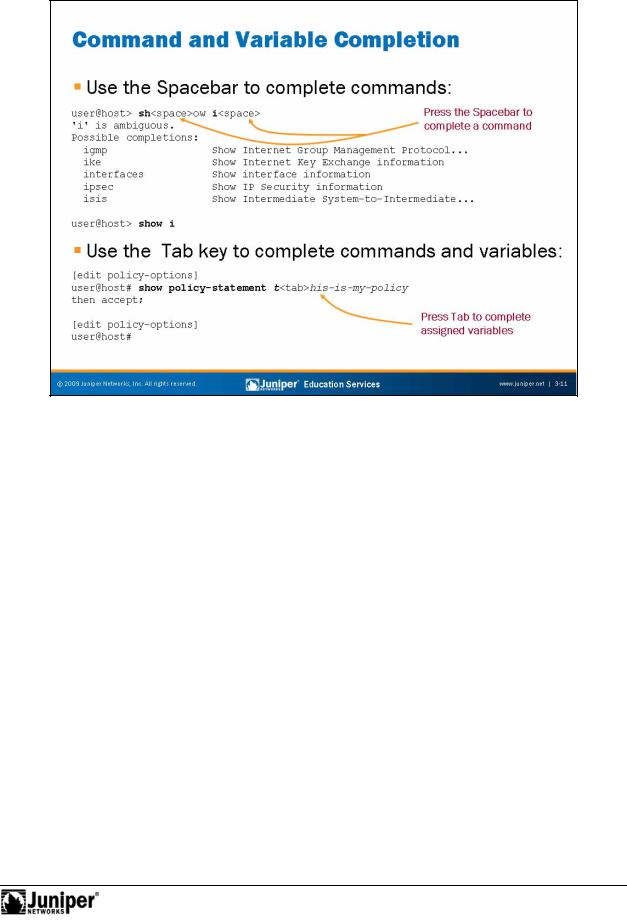
Introduction to JUNOS Software
|
Spacebar Compl |
for Commands |
|
The CLI provides a completion function. Therefore, you are not always required to type |
|
|
the full command or the command option name for the CLI to recognize it. |
|
|
To complete a command or option that you have partially typed, press the Spacebar. If |
|
|
Reproduction |
|
|
the pa tially typed letters begin a string that uniquely identifies a command, the CLI |
|
|
displays the complete command name. Otherwise, the CLI beeps to indicate that you |
|
|
have entered an ambiguous command, and it displays the possible completions. |
|
|
Theforcommand completion option is on by default, but you can turn it off. To disable |
|
|
command completion for an individual user’s session, issue the set cli |
|
|
complete-on-space off command as follows: |
|
user@host> set cli complete-on-space off |
||
Disabling complete-on-space |
|
|
Not |
|
|
Tab Completion for Commands and Variables
You can use the Tab key to complete system commands and user-defined variables. Examples of variables include policy names, AS paths, community names, and IP addresses. The Tab key also offers a list of possible completions if multiple, ambiguous options exist. Command completion allows you to save time by reducing your keystrokes, and prevents errors by accurately referencing the desired user-defined variables.
User Interface Options • Chapter 3–11
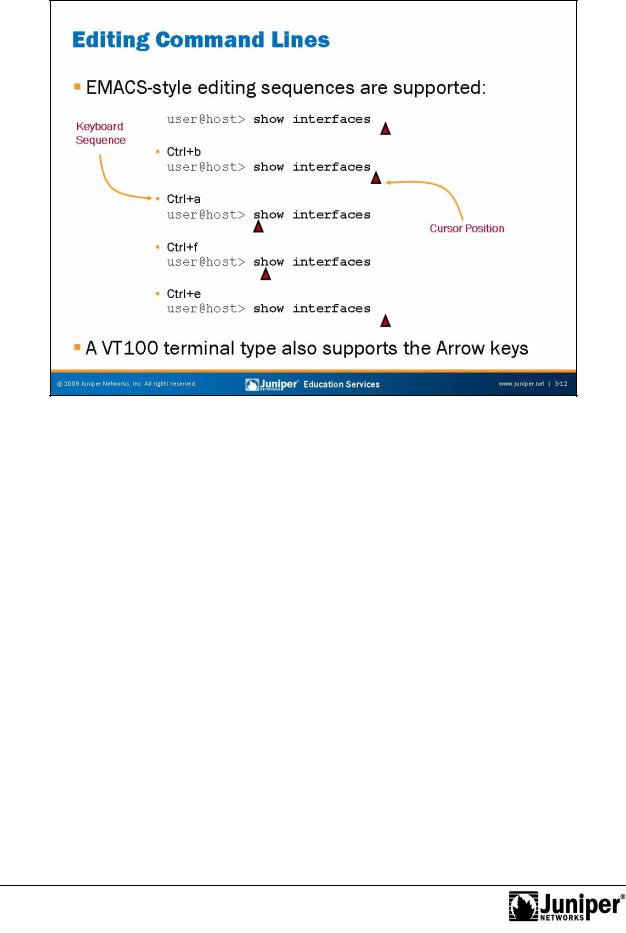
Introduction to JUNOS Software
EMACS-Style ControlReproductionK ys
The CLI supports EMACS-style keyboard sequences that allow you to move the cursor on a command line and delete specific characters or words. The following are supported forsequences:
Ct l+b: Moves the cursor left one character;
Ctrl+a: Moves the cursor to the beginning of the command line; Ctrl+f: Moves the cursor right one character;
Ctrl+e: Moves the cursor to the end of the command line; Delete and Backspace: Deletes the character before the cursor; Ctrl+d: Deletes the character over the cursor;
Ctrl+k: Deletes from the cursor to the end of the line;
Ctrl+u: Deletes all characters and negates the current command; Ctrl+w: Deletes the entire word to the left of the cursor;
Ctrl+l: Redraws the current line; and
Ctrl+p, Ctrl+n: Repeats the previous and next command in the command history, respectively.
on next page.
Chapter 3–12 • User Interface Options
